This post may contain affiliate links. Please read my disclosure and privacy policy.
This Almond Milk recipe is an easy dairy-free alternative that tastes even better than the store-bought variety. All you need is 2 ingredients to get started!

Why You’ll Love It
It tastes amazing. Homemade almond milk tastes far superior when compared to store-bought almond milk, so be warned– you may never want to buy the prepared version again.
It’s easy to make. Just blend almonds and water together in a blender, then strain out the pulp. The entire process can be done in just 5 minutes, minus the time it takes to soak the almonds. (Soaking is optional, though!)
It’s made without preservatives or thickeners. Store-bought milks need to rely on preservatives for a long shelf life, and often add gums and thickeners to make the milk have a uniform consistency. When you make almond milk at home, you can skip those added ingredients.
It’s easy to customize. You can easily add extra flavor to this almond milk recipe, like vanilla or chocolate, depending on your preference. Check out my Vanilla Almond Milk and Chocolate Almond Milk variations, if you want extra guidance.
It’s gluten-free & dairy-free. For those who can’t tolerate cow’s milk, almond milk is an easy lactose-free option. You can use it in smoothies, soups, sauces, cereal, and more!
You can use the pulp, too. Not only will you have delicious almond milk to drink, but you can also use the leftover pulp to make Almond Pulp Hummus or Almond Pulp Brownies.
Ingredients You’ll Need
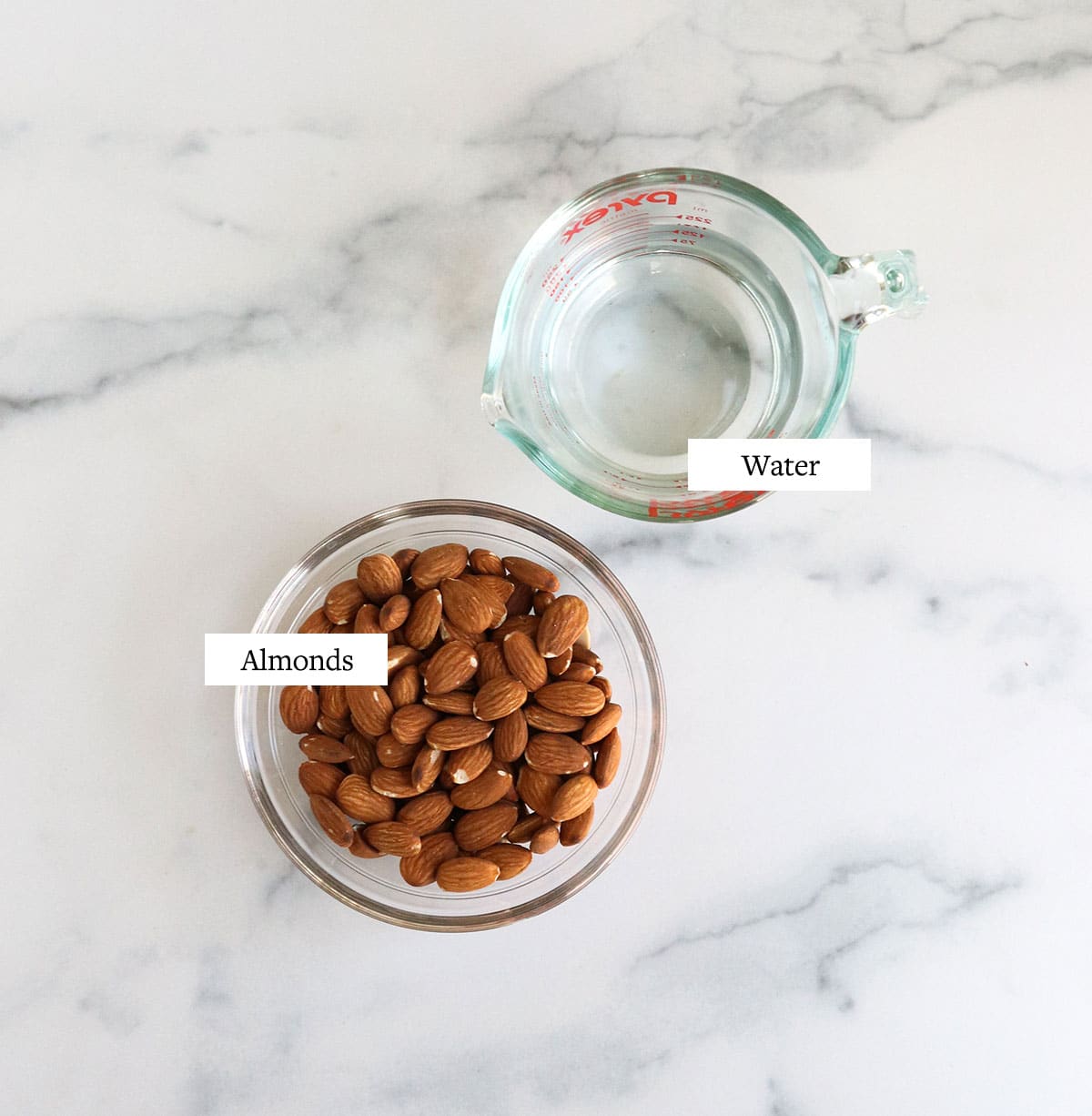
The only two ingredients you need to make almond milk are almonds and water. I tend to use almonds that are not roasted or salted, so the almond milk will have a neutral, mild flavor. However, roasted nuts will work, too!
If you want to make a flavored almond milk, you can also add in vanilla extract and a splash of maple syrup, for sweetness.
How to Make Almond Milk
1. Soak the almonds.
Research doesn’t necessarily support the idea that soaking nuts improves digestion or reduces anti-nutrients, but soaking almonds ahead of time can make them softer and help them break down in your blender easier.
If you want to take the time to do this step, cover the almonds with at least 2 inches of water, so they have room to expand as they soak. (I usually use 2 cups of water to cover 1 cup of almonds.) Let them soak for up to 8 hours, then drain away the soaking water by pouring the almonds into a fine mesh strainer.
You can skip this step if you already have a high-speed blender that can break down almonds effortlessly, or if you’re simply short on time!
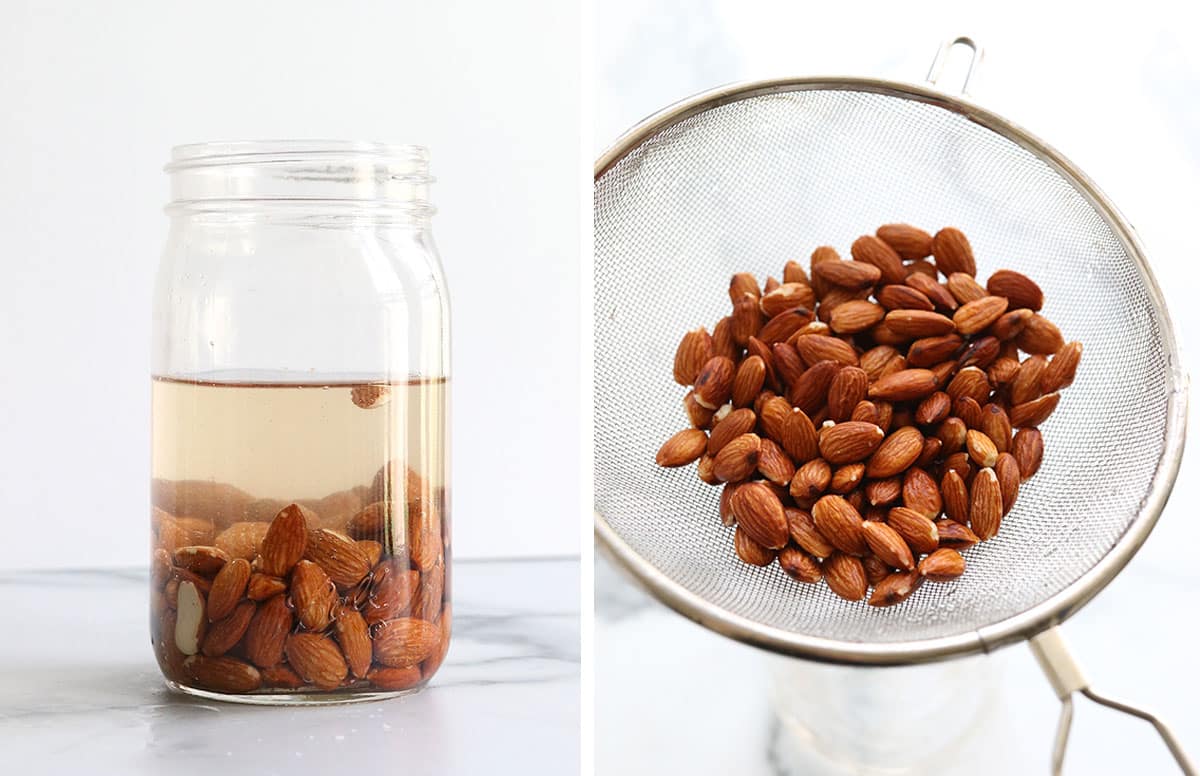
2. Blend.
Add the almonds into a high-speed blender, along with 4 cups of fresh water. Secure the blender’s lid and blend until the almonds are totally broken down and the mixture looks creamy, about 60 to 90 seconds.
There should be almost no visible almond pieces when it’s done blending.

3. Strain.
Arrange a nut milk bag or cheesecloth over a large bowl, then pour the blended almond mixture into the bag. Carefully squeeze the bag, removing as much liquid from the almond pulp as possible.
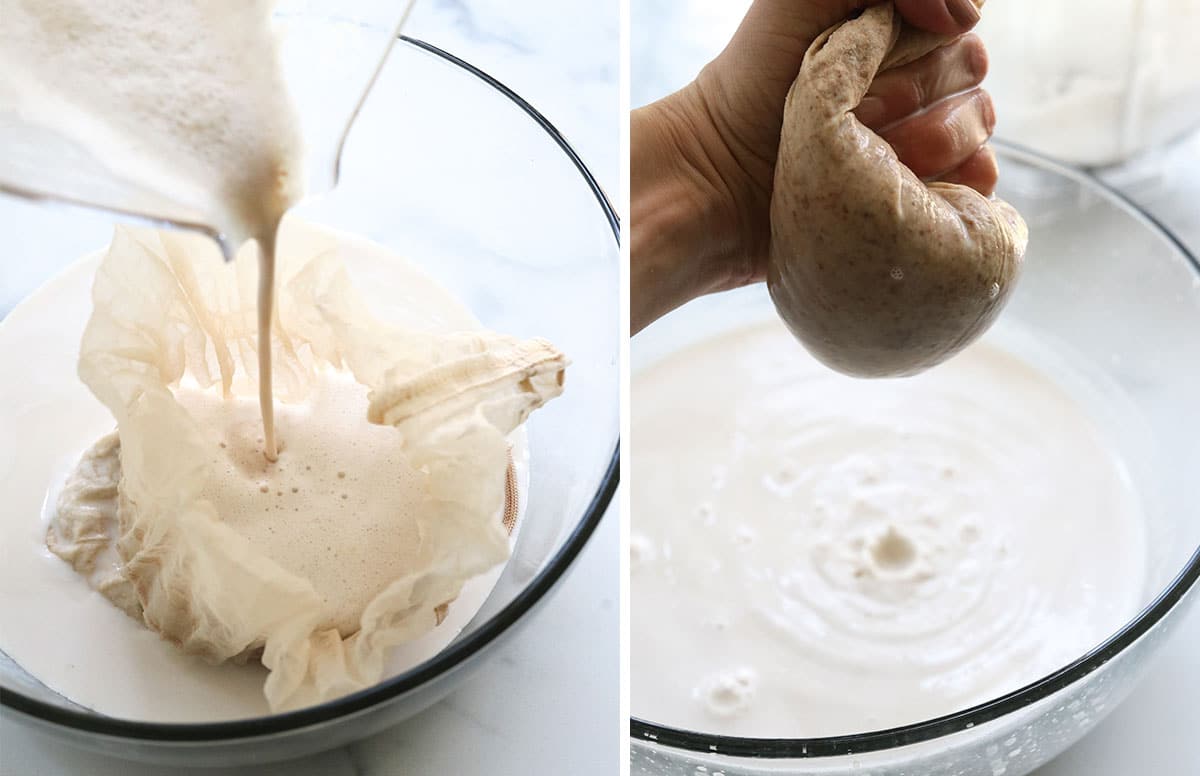
4. Enjoy!
You can use the almond milk right away, or add any extra flavorings to taste, such as vanilla, maple syrup, or a pinch of sea salt. Transfer the almond milk to an airtight container and store it in the fridge for up to 5 days. Or you can freeze it for up to 3 months.
Because this recipe doesn’t call for any preservatives, it won’t last as long as store-bought milks do. (You’ll be able to tell it’s gone off when the smell or flavor goes sour.) Be sure to make only what you’ll drink in a week, or plan on freezing the leftovers. You can easily scale the recipe as needed!
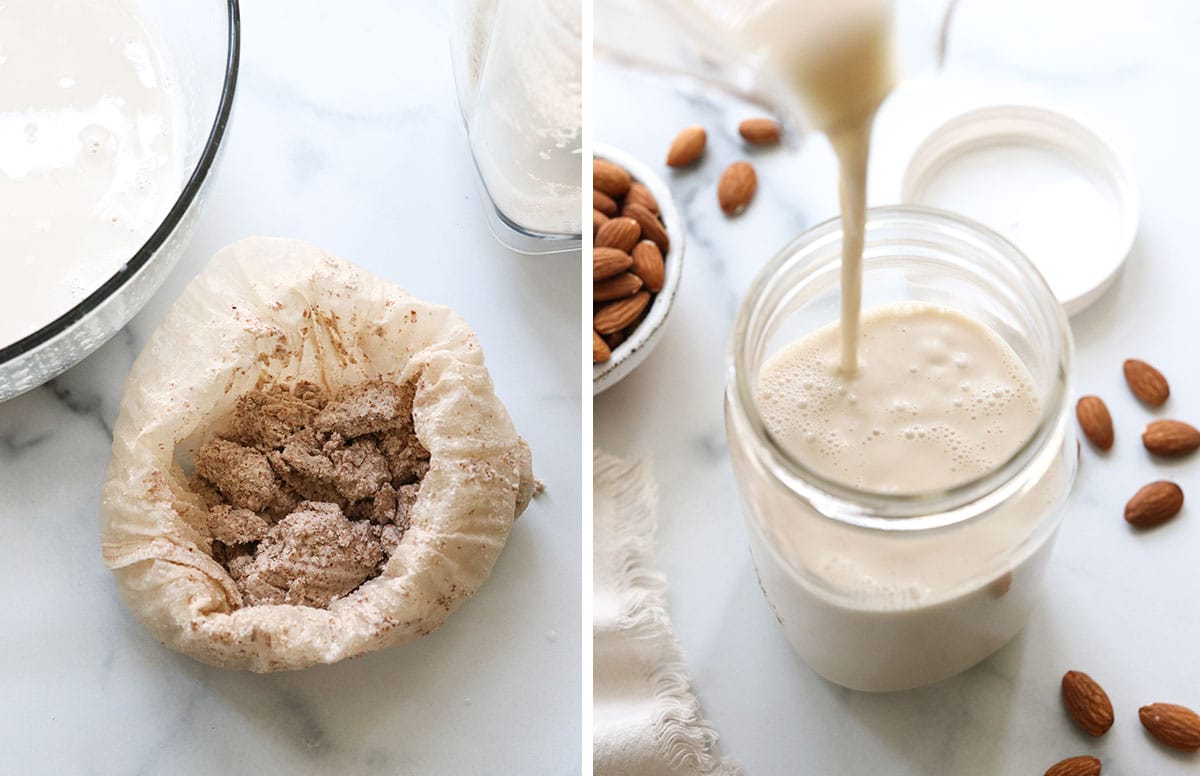
Frequently Asked Questions
Almonds contain important vitamins and minerals, like vitamin E and magnesium. Magnesium is involved in many processes in the body, including blood sugar control, so drinking almond milk may help you reach some of your nutrient needs. It’s also helpful if you are dealing with lactose intolerance, and need a dairy-free alternative.
Straining the almond milk is significantly more difficult when you add cocoa powder into the mix, so it’s best to strain the almond pulp before adding flavoring. This also keeps the almond pulp neutral-flavored, so you can use it in other recipes later (like hummus, which would not work with sweet almond pulp).
You can use the wet almond pulp immediately to make a batch of almond pulp hummus, or you can dry the almond pulp in a dehydrator or low-heat oven and save it to use a flour alternative. It’s not quite the same as almond meal, because some of the fat content has been removed, but it can also work similarly to oat flour in recipes.
Try using it in chia pudding, or over granola, or stirred into your morning oatmeal. It’s also can be frothed to make a foam for lattes, or use it in a chai latte or healthy hot chocolate.
Looking for more dairy-free milk ideas? You can make homemade oat milk for an affordable option, or try hemp milk for extra plant-based protein.
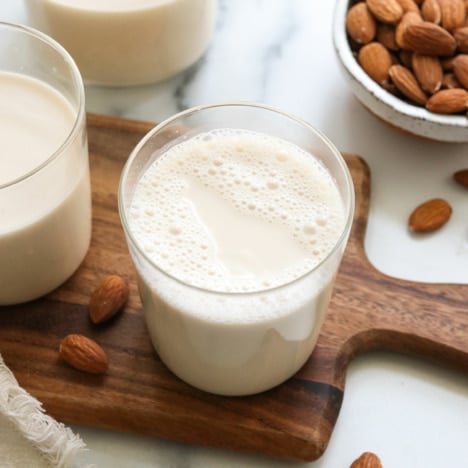
Ingredients
- 1 cup almonds
- 4 cups filtered water
Instructions
- To soak the almonds before blending, cover them with 2 cups of water in a large bowl or jar, and let them soak for 4 to 6 hours. This step is optional, but may help with blending later if you don't have a powerful blender. Drain the almonds through a fine mesh strainer before moving on to the next step.
- Add the almonds and 4 cups of fresh water to a blender. Secure the lid and blend on high-speed for at least 60 seconds, until no pieces of almonds are visible and the mixture looks creamy.
- Pour the almond milk through a nut-milk bag or cheese cloth, squeezing well to extract the milk. You can save the remaining almond pulp for another recipe (see the full post for ideas) or discard. If you would like to flavor the almond milk with vanilla or chocolate flavorings, this is the time to whisk in any additions.
- Store the almond milk in an airtight container in the fridge for up to 4 days. (You can freeze leftovers, if needed, for up to 3 months, too!)
Video
Notes
Nutrition
If you try this almond milk recipe, please leave a comment and star rating below letting me know how you like it!


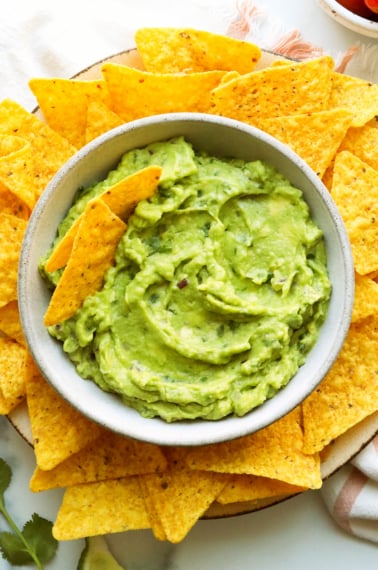
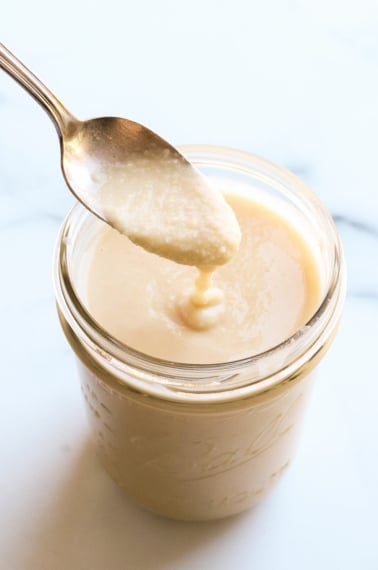
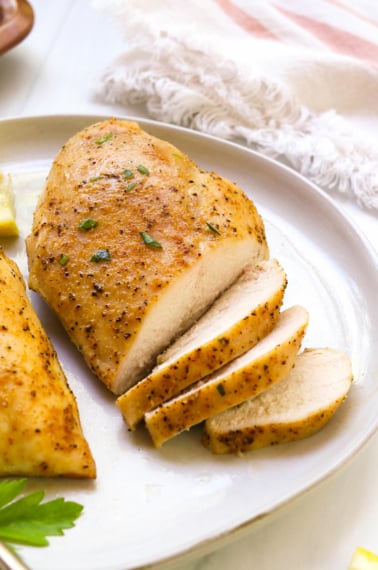







Hi Megan, also just found your website – love it. Thank you! Wondering what brand the jar is in the picture? Thanks!
I bought that container at Target 3 years ago. I don’t use it anymore, because it’s plastic, but I think they make a glass version now!
I actually use this new air-tight glass container for my almond milk now: http://amzn.to/10GubsE I love that I can fit my entire hand through the top for cleaning purposes– a very important feature when you use the same container for almond milk over and over again!
Making almond milk every couple of days would get a little cumbersome for my schedule – do you think freezing it would be a problem? I am thinking of making it once a week and having enough to get us through… We drink raw cow’s milk but would like to ween off of that a bit.
I usually only make mine once a week, and it seems to keep in the fridge quite well. I bet freezing it would work, too!
Just found your site- awesome! thank you for your posts! I didn’t read all the comments above, but if yo happen to have a dehydrator on hand… you can dehydrate the almond pulp left over from the milk to make your almond flour. that way you get two items- milk and flour. More bang for your buck! You can do the same with coconut milk pulp. 🙂 it comes out so nice and fine in the vitamix. 🙂
I was wondering if you have tried making flax milk. The only recipes I could find were sweetened and I prefer unsweetened for cooking and topping my granola. Also would you use the leftover grounds the same way as the almond milk?…as flax meal?
I’ve never tried making flax milk, so I’m not sure!
Thank you for your reply. Do the diffferent oils that they are roasted in mutate at high heat or the almond oil itself? I will look for organic almonds, even though they are treated with something else;at least I know they are not contaminated with the carcinogenic gas. Thanks again.
I was referring to the oil that naturally occurs in the almonds themselves. Any additional oil used for roasting would also be of concern, though!
Hi, I see there is a mention of using raw blanched almonds but I didn’t actually see what kind of almonds you use in your recipe. Do you use roasted almonds, as I have read that raw almonds are not really raw and are can be treated with dangerous carcinogen gases to prevent salmonella. I’m not sure what kind of almonds you are using to make this milk. I want to steer clear of raw almonds in the store from now on.
I always use organic almonds, and organic raw almonds if they are available. Organic raw almonds cannot be treated with those dangerous gasses, so it’s only the conventional raw almonds you have to worry about. I prefer to avoid roasted almonds, as their oils can mutate at high heat and those would not be healthful to consume.
I JUST made this 🙂 I used some up Trader Joes sesame honey almonds that I wasn’t going to eat. Next time I’ll get some organic ones. I whizzed it up in my vitamix and HOLY cow. It got so foamy and incredibly thick and delicious! I added more water to mine and I’ve got a BUNCH now in the fridge. Why do you say only keep for 4 days? I don’t think I can drink all I made in four days, and see no reason why it won’t last longer 🙂
I estimate 4 days to be on the safe side– it will often last longer! Keep in mind that this almond milk has no preservatives, so the flavor will go “off” quicker than store-bought almond milk. You’ll definitely be able to taste a difference if that happens!
Another question…I thought I saw it addressed in the comments, but now I can’t find it. Could I use raw blanched almonds? Found them for $28.30/4 lbs…and no peel! Would I still need to strain them? I do like the idea of making flour from the leftovers tho!
Sure, I don’t see why not! I would still strain them, though.
Holy Mother of Almonds…I am completely addicted to this site! I’m new to all this, but after being diagnosed with diabetes four months ago, I’ve lost 38 lbs and am obsessed with eating better! Giving up moo milk wasn’t easy, but the carb count alone made it simple! I bought unsweetened, unflavored almond milk and love it for cooking, but just cant drink it…I think its the thickness. Is your almond milk thick too? If so, would adding more water change the composition too much for other uses? I prefer the not sweet stuff, glad this has nothing added! Thanks…I LOVE this place! 🙂
No, homemade almond milk is not thick since there are no added fillers or preservatives. It’s delicious!
Thank you for posting this, I am a huge almond milk fan and can’t wait to try this! This might be a dumb question, but I’ve never done anything like this… Can you re-use the nut milk bag?
Yes, I’ve been using the same one for years!